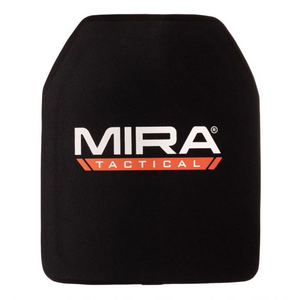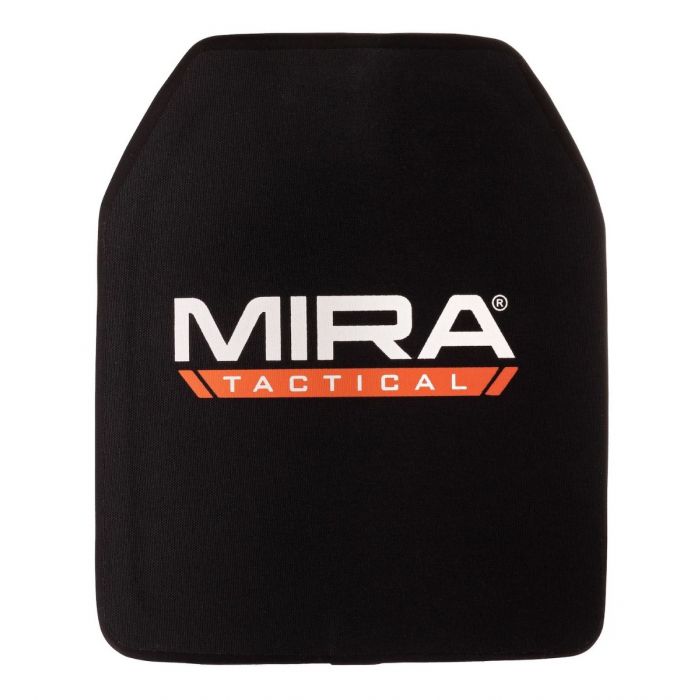Your cart is empty


MIRA Safety is proud to introduce the MIRA Tactical product line and debut a line of 5.9 pound lightweight Level IV body armor. It’s designed to stop multiple impacts from armor-piercing ammunition.

Tested to NIJ standards at a US-based laboratory, MIRA Tactical's Single Curve, Shooter’s Cut 10” x 12” ESAPI armor plates offer an enhanced range of motion and protects the wearer from all types of small arms up to and including armor-piercing high-powered rifle rounds in 5.56, 7.62, .308, and 30-06 calibers.
Unlike typical ceramic plates, which can splinter and crack and only protect against single-shot threats, Mira Tactical’s Level IV plates combine the benefits of both ceramic and polyethylene. They are lightweight ballistic plates that are easy to deploy, and they provide outstanding life-saving protection, making a great addition to one’s survival kit.
Key Features:
The Highest Level of Ballistic Body Armor Protection Doesn’t Have to Weigh 10 lbs.
Throughout 2020, even as the global pandemic shut down many cities and states, gun violence soared. Cities deemed safe only months ago are now witnessing gun violence at epidemic levels.
It’s a sobering reminder that a bad situation can always get worse, and that preparing to protect yourself and your family from any threat means protecting yourself from the human element as well. With hundreds of vendors on the market selling dozens of types of body armor, how can you possibly know which one is right for you?
That’s where MIRA Tactical’s Level IV Body Armor comes in.
Like all of our protective offerings, our new poly-ceramic blend armor makes absolutely zero compromises in terms of quality and reliability. We’ve used the most advanced methods and materials to deliver a lightweight practical solution for everyone, from first-time buyers to those experienced with body-armor seeking to upgrade, all while adding some much-needed protection to a tactical backpack or setting up a concealed armor rig.
Most affordable armor solutions on the market today limit you to Level IIIA, Level III, or Level III+ in terms of overall protection. Adding our Level IV body armor plates can significantly enhance protection for vital organs or turn your everyday backpack into a concealed armor shield, at an extremely low weight.
The key to our Level IV Body Armor’s lightweight strength lies in the combination of Alumina Oxide Ceramic (AI203) and ultra-high molecular weight polyethylene (UHMWPE), which are both lighter and more durable than the steel used in most Level III armor. Early adopters in police and special forces military units can already attest to the lifesaving power of these lightweight composites.
After fabrication, the plates are shaped to the standard 10” x 12” size used for most plate carriers with a standard right-hand shooter’s cut for improved comfort. Initial plates were tested with armor piercing 5.56 mm and 30.06 rifle rounds, withstanding multiple shots in each test.
The end result? A sub-6-pound plate that’s less than an inch thick can stop multiple 3,000 feet-per-second armor-piercing battle rifle rounds.
And unlike most steel and ceramic Level IV offerings that weigh anywhere from 7.5–13 pounds, the MIRA Tactical Level IV plate won’t break your back, literally, helping you avoid long-term lower back, hip, and knee ailments caused by carrying heavy loads.
MIRA Safety is proud to offer our new MIRA Tactical Level IV Body Armor to police, military personnel, independent security contractors, and US-based civilians. It’s what we wear.
Storage
UHMWPE plates must not be exposed to 150℉ temperatures for prolonged periods. Extended exposure to extreme heat can potentially compromise the plate’s integrity and reduce its protective abilities. Please note that this is a conservative figure, and it’s unlikely that you even be able to find 150℉ temperatures, but it’s worth noting that your armor is best stored in a cool, dry, dark place away from extreme heat.
What does “Level IV” protection mean?
Body armor standards are established by the National Institute of Justice, and they help buyers know what kind of protection they’re getting. Level IIIA armor, for example, is rated to stop pistol rounds up to and including .357 Magnum. Level III armor can stop some rifle rounds like the 7.62 x 39. The higher the armor, the greater the protection, and generally the higher the weight and cost. That’s the beauty of the MIRA Tactical Level IV plate, which provides armor-piercing protection with a slim profile (5.9 lbs.) that is lightweight (5.9 lbs.), comfortable (single curve), and in a shooter’s cut (excellent range of motion).
What does "assembled in the USA" mean?
The ceramic (Alumina Oxide) and UHMWPE (Polyethylene) materials are sourced from a trusted partner in Asia, based on our specifications. Upon arrival at our facility in Phoenix, AZ, those materials are inspected to ensure they meet our requirements and standards. Upon approval, those materials are then bound together utilizing our proprietary binding agent that includes our RDT (Round Dispersion Technology) sealant. Finally, the plates are wrapped with a high-density 600D water-resistant Nylon liner.
What is the difference between Ballistic UHMWP and Commercial UHMWP? What are the technical specs of the MIRA Tactical Level 4 Body Armor?
The Ultra High Molecular Weight, High-Performance Polyethylene Material (UHMWPE) used in our plate offers high protection in ballistic applications and significant advantages through low backface deformation, superior rigidity, and increased survivability. The major differences between the ballistic capable UHMWPE and the commercial grades of UHMWPE are as follows:
With the Ballistic version having a greater Areal Density and a higher Modulus than the commercial versions. Commercial versions are typically found in the manufacturing of medical & food processing, conveyor belts, and industrial products, as well as low grade, cheap ballistic products.
Our Ballistic PE Specs
Continuous unidirectional (UD) fabric is manufactured with an Ultra-High Molecular Weight Polyethylene fiber based on composite laminate. A roll of fabric consists of double-two fibers of unidirectional sheet cross piled at 90 degrees to each other, with a special adhesive rubber and glue film. The UD fabric has high strength and high modulus, and is resistant to corrosion, acid, alkali, UV light, and moisture.
Therefore, it can be widely applied to bulletproof products, ballistic and anti-stab products, ballistic armor plates, etc.
| Areal Density: | 240 (±2.5) g/m² |
| Strength: | ≥38 g/d |
| Modulus: | ≥1300 g/d |
| Strands: | 240 |
| Monofilament Fitness: | 2.5 |
| Elongation at break: | ≈2.8 |
| Shrinkage: | <1% |
| Melting Mass Temperature: | 144~152 ⁰C |
We test our products to the NIJ Standard 0101.6 and beyond. This includes the following:
Ref Sec. 6 Hard Armor Conditioning Protocol
Purpose and Scope: This section is designed to subject hard armors or plate inserts to conditions that are intended to provide some indication of armor’s ability to maintain ballistic performance after being exposed to conditions of heat, moisture, and mechanical wear. This protocol is intended to apply only to rigid systems. After this armor conditioning protocol, the ballistic performance will be verified with ballistic testing as described in section 7.
(1) a 24-h acclimation period to ensure all items at any intended climatic test location will start with the same conditions,
(2) a 10-d uniform thermal exposure,
(3) a thermal cycle exposure, and
(4) mechanical durability testing.
Ref Sec.7 Ballistic Test Methods
Purpose and Scope: This section specifies the methods and performance requirements for ballistic testing of body armor and includes the formal test procedures for the Perforation Backface Signature (PBFS)and baseline Ballistic Limit (BL) tests. The first test series is P-BFS testing and requires the armor to demonstrate consistent ballistic resistance to both perforation and excessive blunt force trauma. The second test series is BL testing and is designed to statistically estimate perforation performance. In addition, for flexible vests and jackets, a portion of the sample set will be subjected to the flexible armor conditioning protocol described in section 5. For hard armor and plate inserts, the entire sample set will be subjected to the hard armor conditioning protocol described in section 6. The conditioned samples will be subjected to ballistic testing.
Why is armor sold in plates?
Armor is historically quite heavy, but it’s also only necessary to protect vital organs of the chest and thorax area. So for increased mobility, military and police users wear “plate carrier” vests that allow them to swap out armor plates as needed.
Isn’t body armor heavy and awkward?
Historically yes. Old steel and ceramic armor can weigh over 10 pounds per plate or more. Thanks to innovations in composite armor, you can get meaningful protection for about 6 pounds (see above). That’s about what a brick weighs, and if you’re carrying it around in a backpack or plate carrier it’s manageable on a daily basis.
Can I trust new poly-ceramic body armor?
The US military and thousands of police officers already trust poly-ceramic body armor, and dozens if not hundreds have been saved by their poly-ceramic body armor. The poly-ceramic blend takes ceramic plates to the next level. The poly coating reduces the weight by more than 5 pounds and provides a protective coating that exponentially improves durability. Although these materials are still relatively new, they have absolutely been proven in the field.
Can anyone buy body armor?
Anyone other than a convicted felon can purchase ballistic body armor. However, Connecticut state law prohibits purchasing body armor online and having it shipped to you.
Can I take body armor on a plane?
Body armor is legal in all 50 states and can be transported and worn over state lines. You cannot be arrested for wearing body armor, and your armor cannot be confiscated. In fact, traveling with body armor is just as easy as traveling with a jacket. You may wear it onboard, take it in your carry-on luggage, or transport it in checked baggage.
What do “stand alone” and “ICW” mean?
This is a critical distinction that you need to be aware of when purchasing a ballistic armor plate. Stand alone means that the plate alone provides you with the stated level of protection. ICW means “in conjunction with and it indicates that the plate must be worn in conjunction with another level of protection to provide the stated protection level.
Why does body armor have a lifespan?
All soft body armor has a lifespan because ballistic materials degrade over time. Typically, the lifespan of soft armor is 5 years, and it is important to confirm the expiration date with the manufacturer. Even the world’s strongest materials degrade with age, and it is important that you know when your armor will expire.
MIRA Tactical Level 4 Body Armor Test Results